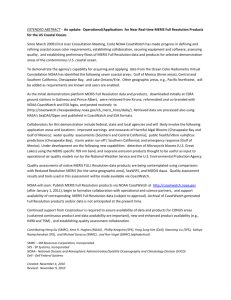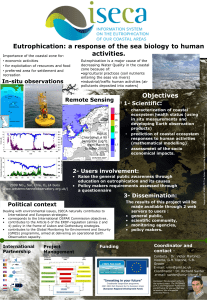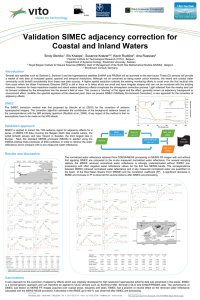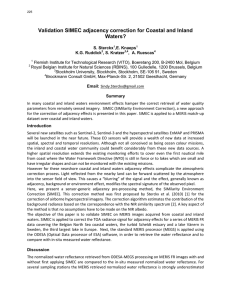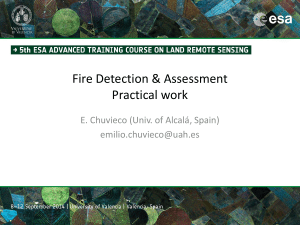MULTITEMPORAL UNMIXING OF MERIS FR DATA
advertisement
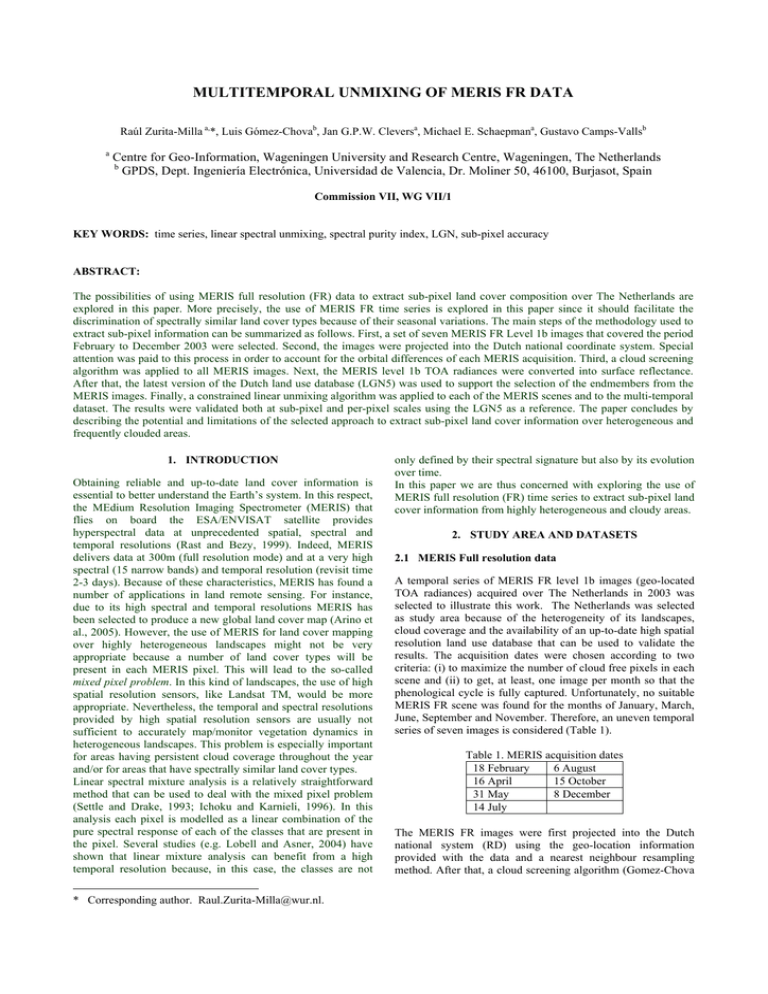
MULTITEMPORAL UNMIXING OF MERIS FR DATA
Raúl Zurita-Milla a,*, Luis Gómez-Chovab, Jan G.P.W. Cleversa, Michael E. Schaepmana, Gustavo Camps-Vallsb
a
Centre for Geo-Information, Wageningen University and Research Centre, Wageningen, The Netherlands
b
GPDS, Dept. Ingeniería Electrónica, Universidad de Valencia, Dr. Moliner 50, 46100, Burjasot, Spain
Commission VII, WG VII/1
KEY WORDS: time series, linear spectral unmixing, spectral purity index, LGN, sub-pixel accuracy
ABSTRACT:
The possibilities of using MERIS full resolution (FR) data to extract sub-pixel land cover composition over The Netherlands are
explored in this paper. More precisely, the use of MERIS FR time series is explored in this paper since it should facilitate the
discrimination of spectrally similar land cover types because of their seasonal variations. The main steps of the methodology used to
extract sub-pixel information can be summarized as follows. First, a set of seven MERIS FR Level 1b images that covered the period
February to December 2003 were selected. Second, the images were projected into the Dutch national coordinate system. Special
attention was paid to this process in order to account for the orbital differences of each MERIS acquisition. Third, a cloud screening
algorithm was applied to all MERIS images. Next, the MERIS level 1b TOA radiances were converted into surface reflectance.
After that, the latest version of the Dutch land use database (LGN5) was used to support the selection of the endmembers from the
MERIS images. Finally, a constrained linear unmixing algorithm was applied to each of the MERIS scenes and to the multi-temporal
dataset. The results were validated both at sub-pixel and per-pixel scales using the LGN5 as a reference. The paper concludes by
describing the potential and limitations of the selected approach to extract sub-pixel land cover information over heterogeneous and
frequently clouded areas.
1. INTRODUCTION
Obtaining reliable and up-to-date land cover information is
essential to better understand the Earth’s system. In this respect,
the MEdium Resolution Imaging Spectrometer (MERIS) that
flies on board the ESA/ENVISAT satellite provides
hyperspectral data at unprecedented spatial, spectral and
temporal resolutions (Rast and Bezy, 1999). Indeed, MERIS
delivers data at 300m (full resolution mode) and at a very high
spectral (15 narrow bands) and temporal resolution (revisit time
2-3 days). Because of these characteristics, MERIS has found a
number of applications in land remote sensing. For instance,
due to its high spectral and temporal resolutions MERIS has
been selected to produce a new global land cover map (Arino et
al., 2005). However, the use of MERIS for land cover mapping
over highly heterogeneous landscapes might not be very
appropriate because a number of land cover types will be
present in each MERIS pixel. This will lead to the so-called
mixed pixel problem. In this kind of landscapes, the use of high
spatial resolution sensors, like Landsat TM, would be more
appropriate. Nevertheless, the temporal and spectral resolutions
provided by high spatial resolution sensors are usually not
sufficient to accurately map/monitor vegetation dynamics in
heterogeneous landscapes. This problem is especially important
for areas having persistent cloud coverage throughout the year
and/or for areas that have spectrally similar land cover types.
Linear spectral mixture analysis is a relatively straightforward
method that can be used to deal with the mixed pixel problem
(Settle and Drake, 1993; Ichoku and Karnieli, 1996). In this
analysis each pixel is modelled as a linear combination of the
pure spectral response of each of the classes that are present in
the pixel. Several studies (e.g. Lobell and Asner, 2004) have
shown that linear mixture analysis can benefit from a high
temporal resolution because, in this case, the classes are not
* Corresponding author. Raul.Zurita-Milla@wur.nl.
only defined by their spectral signature but also by its evolution
over time.
In this paper we are thus concerned with exploring the use of
MERIS full resolution (FR) time series to extract sub-pixel land
cover information from highly heterogeneous and cloudy areas.
2. STUDY AREA AND DATASETS
2.1 MERIS Full resolution data
A temporal series of MERIS FR level 1b images (geo-located
TOA radiances) acquired over The Netherlands in 2003 was
selected to illustrate this work. The Netherlands was selected
as study area because of the heterogeneity of its landscapes,
cloud coverage and the availability of an up-to-date high spatial
resolution land use database that can be used to validate the
results. The acquisition dates were chosen according to two
criteria: (i) to maximize the number of cloud free pixels in each
scene and (ii) to get, at least, one image per month so that the
phenological cycle is fully captured. Unfortunately, no suitable
MERIS FR scene was found for the months of January, March,
June, September and November. Therefore, an uneven temporal
series of seven images is considered (Table 1).
Table 1. MERIS acquisition dates
18 February
6 August
16 April
15 October
31 May
8 December
14 July
The MERIS FR images were first projected into the Dutch
national system (RD) using the geo-location information
provided with the data and a nearest neighbour resampling
method. After that, a cloud screening algorithm (Gomez-Chova
et al., 2006) was applied to all the images to identify and mask
out cloud contaminated pixels. Then, the TOA radiances were
transformed into surface reflectance using an algorithm
specifically designed for the MERIS sensor (Guanter et al.,
2007). This algorithm is intended for correction of land targets
because the low accuracy of aerosol optical thickness retrievals
over water. However, in this study, the algorithm was modified
to include the first 10km of water from the shoreline in order to
obtain surface reflectance over coastal and inland waters, which
represent a high percentage of the total area of The Netherlands.
2.2 Reference dataset
The latest version of the Dutch land use database, the LGN5,
was used as a reference in this study. This geographical
database is based on a multi-temporal classification of high
resolution satellite data acquired in 2002 and 2003; several
types of ancillary data were also used to produce the land use
database – see (Hazeu, 2005) for more details. The LGN5 has a
pixel size of 25m and maps 39 classes. The unmixing of all
these classes would be unrealistic, since some of the classes are
rather small and/or sparsely distributed and/or heavily based on
available ancillary data, which mainly describes land uses
rather than land covers types. Consequently, the LGN5 was
thematically aggregated into the main 12 and 4 land cover types
of The Netherlands. The aggregation to 12 classes is meant to
offer a detailed distribution of the following classes: grassland,
summer crops, winter crops, orchards, deciduous forest,
coniferous forest, water, built-up, greenhouses, bare soil
(including sand dunes), heathlands, and swamps. The
aggregation to 4 classes considers the following main land
cover classes: vegetation, bare soil, water and built-up. Despite
its simplified legend, the aggregation to 4 classes is of great
interest because it can be used as a proxy of fractional
vegetation cover and because it might be of help during the
inversion of biophysical and biochemical parameters. For
example, the presence of sub-pixel water in a pixel might bias
the LAI estimate.
3. SPECTRAL UNMIXING
A fully constrained linear spectral unmixing (FCLSU) was
applied to each MERIS image (mono-temporal case) as well as
to a multitemporal composite (layerstack) of all the MERIS
images. The FCLSU (Heinz and Chang, 2001), which
guarantees a physical interpretation of the results, can be
formalized as follows:
pi =
c = nc
∑( f
c =1
c
⋅ μ ci ) + ε i
(1)
Subject to:
0 ≤ fc ≤ 1
c = nc
and
∑f
c =1
c
=1
(2)
where pi is the pixel value for the band-i, nc represents the
number of classes that are being unmixed, fc is the fraction of
class-c present in the pixel, and μci is the pure signal of the
class-c in the band-i (this signal is commonly known as “class
endmember”). Finally, the term εi represents the per band
residual error.
Notice that the number of dates used in multitemporal unmixing
is pixel dependent (each pixel was unmixed with the maximum
number of cloud free dates). This means that the quality of the
unmixing might also be pixel-dependent and that, if critical
(phenological) dates are missing for a number of pixels (areas),
the accuracy of the results on those pixels (areas) might be
lower.
3.1 Selection of endmembers
A fully automatic class endmember selection method was used
in this study. The method only needs the land cover fractions
computed for each MERIS date using the LGN5 as a reference
and the cloud mask that belongs to each MERIS image. First,
the fractions of each land cover class were summed up for all
the acquisition dates. Next, these “multitemporal fractions”
were used to compute a multitemporal version of the standard
purity index, SPI (Zurita-Milla, 2007):
SPI =
c = nc
∑( f
c =1
c
− f maxclass )
2
(nc − 1)
(3)
where fc represents the multitemporal fraction of class-c in a
given pixel and fmaxclass is the maximum multitemporal fraction.
Therefore, the multitemporal SPI equals one when the pixel has
only one class for all the dates under study, and it equals zero
when the sum of the fractions is the same for all the classes (fc =
fmaxclass = 1/nc).
Pure pixels were identified for each date by first applying the
corresponding cloud mask to the multitemporal SPI image and
then applying a SPI threshold to the remaining (cloud free)
pixels. The SPI threshold was adaptively tuned until at least 20
pixels were found for all classes. After that, a neighbourhood
constraint is applied to these SPI pure pixels: only the pure
pixels surrounded by pure pixels of the same land cover class
are selected to compute the endmembers (erosion filter of 3 by
3 pixels). If after applying the neighbourhood constraint a class
has less than 5 pixels left, then the constraint is relaxed and all
the pixels identified in the previous step are selected as pure
pixels to compute the endmember of that class. Finally, the
endmembers of each class were created by averaging the pure
pixels identified in the previous step.
3.2 Validation datasets
Although the MERIS sensor has a large swath that allows a
revisit time of 2-3 days, the ENVISAT platform only repeats
orbit every 35 days. This means that each of the MERIS images
that were selected for the analysis might have been acquired
from a slightly different orbit. This, in turn, implies that each of
the MERIS images might have a slightly different observation
geometry. Therefore some (sub-pixel) differences in the
instantaneous field of view of each “pixel” are to be expected
when using images acquired from different orbits.
In order to account for this effect, each MERIS pixel was
reprojected into the original LGN5 25m grid so that the “actual
land cover fractions” seen by MERIS at each acquisition date
could be computed. After this, the sub-pixel land cover
fractions were assigned to the corresponding 300 by 300m
MERIS pixel. The class having the highest fractional coverage
was used to produce a hard land cover classification for each
MERIS acquisition date. This processing step allows both a
sub-pixel and a per-pixel validation of the unmixing results for
each of the MERIS FR images.
In order to create a validation dataset for the multitemporal
results, the LGN5 was spatially aggregated to match the
nominal MERIS FR pixel size. A majority filter with a kernel of
12 by 12 LGN5 pixels was used to obtain a land cover
classification map at 300m. During this spatial aggregation, the
fractions of the different land cover types present in each 300
by 300m pixel were recorded.
3.3 Accuracy assessment
The fractional maps computed in the previous section were used
as ground truth for the validation of the monotemporal and
multitemporal unmixing. Assuming that the unmixed fractions
are correctly positioned within each pixel, a kind of overall subpixel accuracy (OSA) can be computed as follows:
OSA =
c = nc
∑ dc
c =1
{
d c = min f
c = nc
∑
c =1
LGN 5
c
c = nc
fc =∑ dc
, fc }
differences due to different acquisition orbits). Images also
overlapped quite well the reference dataset. This can be
considered as a preliminary quality proof of the ground control
points provided with the images. Although a quantitative
assessment of the geolocation accuracy might have been more
appropriate, here we decided to keep it simple in order to also
test the operability of the unmixing of MERIS FR time series.
Therefore, in this study, the pre-processing steps were reduced
as much as possible.
With respect to the cloud screening method, all the clouds and
cloud borders were masked out. The validation of the cloud
mask revealed that a small amount of pixels belonging to the
classes greenhouses (sun glint on glass roofs) and bare soil
(sand dunes) were identified as clouds because these classes
have similar reflectance behaviour as clouds. However, the
classes that were misclassified represent less than 0.5% of The
Netherlands and, therefore, they are not statistically
representative in the clustering process used by the cloud
screening algorithm.
(4)
c =1
where dc are the correctly classified abundances for each pixel.
These abundances can be computed as the minimum of fcLGN5
and fc, which respectively are the LGN-based and the unmixed
abundances. Notice that the sum of fc for all classes adds to
unity (Eq. 2).
After the sub-pixel accuracy assessment, the unmixed fractions
were used to produce land cover classification maps for each
date. The class having the maximum fractional coverage was
used to label each pixel. Subsequently, a classical classification
accuracy assessment was done by comparing these images with
the land cover maps that were computed for each date.
Similarly, the hard classified multitemporal image was
validated using the aggregated LGN5 as a reference. The
confusion matrix and the kappa index were used for the perpixel accuracy assessment.
4. RESULTS AND DISCUSSION
Figure 1. Total number of usable dates
Figure 1 shows the number of usable dates for each MERIS FR
pixel. It should be noted that the northern and south-eastern
parts of the Netherlands have less usable pixels than the rest of
the country. This is not only because of the cloud coverage but
also because some of the MERIS FR images did not cover the
whole of The Netherlands.
4.1 MERIS pre-processing
A visual inspection of the reprojected MERIS images did not
show any major shift between them (besides the expected
Surface Reflectance
0.5
Grassland
Summercrops
Wintercrops
Orchards
Greenhouses
Deciduousforest
Coniferousforest
Water
Built−up
Baresoil
Heathlands
Swamps
0.4
0.3
0.2
0.1
0
Jan
Feb
Mar
Apr
May
Jun
Jul
Aug
Sep
Oct
Nov
Dec
Figure 2. Spectral signature of the endmembers extracted from the MERIS FR time series.
Table 2. Summary of the accuracy assessment for the 12 classes case
Date
mean OSA
Kappa
OA
18-2-2003
43.54
0.33
44.29
16-4-2003
52.70
0.44
54.17
Date
mean OSA
Kappa
OA
18-2-2003
77.20
0.52
80.83
16-4-2003
82.84
0.73
88.27
31-5-2003
42.35
0.33
43.88
14-7-2003
45.46
0.36
46.06
6-8-2003
36.88
0.27
35.29
15-10-2003
41.56
0.30
41.87
8-12-2003
44.78
0.32
45.68
Multitemp
52.72
0.45
55.17
8-12-2003
74.28
0.50
77.56
Multitemp
82.51
0.71
87.81
Table 3. Summary of the accuracy assessment for the 4 classes case
31-5-2003
78.21
0.60
83.09
14-7-2003
83.07
0.69
87.28
6-8-2003
80.01
0.58
82.54
15-10-2003
74.52
0.50
76.66
Table 4. User’s and producer’s accuracies (UA and PA, respectively) for the 12 classes case
Class
UA
PA
Grassland
70.96
72.90
Summer Crops
58.40
26.29
Winter Crops
17.59
18.58
Orchards
4.19
0.97
Greenhouses
16.27
68.66
Deciduous. Forest
13.40
35.79
Class
UA
PA
Coniferous Forest
50.09
71.78
Water
86.95
88.70
Built-up
71.67
41.45
Bare soil
10.79
37.17
Heathlands
13.72
31.88
Swamps
5.05
15.17
Table 5. User’s and producer’s accuracies (UA and PA, respectively) for the 4 classes case
Class
UA
PA
Vegetation
87.58
98.05
Bare soil
36.65
24.71
Water
92.55
84.79
Built-up
78.42
25.59
4.2 Endmembers
Most of the endmembers were computed as average of the
pixels selected using the initial SPI threshold of 0.95.
Nevertheless, for some small classes, the SPI threshold was
reduced in order to get, at least, 20 pixels for those classes.
For instance, the SPI threshold had to be reduced to 0.87 to
extract 20 “pure pixels” of the greenhouse class on cloudy dates
(31st May and 6th August). For the small and sparse classes the
neighbourhood constraint was, in general, not applied because
very few clusters of 3 by 3 pure pixels can be found.
Figure 2 shows the spectral signature of the endmembers
selected in this study. Grassland presents the highest NIR
reflectance all year around. During the months of May, July and
August the endmember of deciduous forest also shows high
reflectance (high greening of vegetation). The rest of the
vegetated classes appear to have a very similar spectral
signature. Therefore, high confusion is expected among most of
the vegetated classes.
4.3 Unmixing
A fully constrained linear spectral unmixing was applied to
each of the seven MERIS images and to the multitemporal time
series using the 12 endmembers depicted in figure 2. The
fractions for the 4 classes case were computed by aggregating
all the fractions of vegetated classes into a single vegetation
class and by grouping the fractions of greenhouses and built-up
into a single built-up class. The unmixed fractions were then
compared with the reference fractions that were generated
according to the viewing geometry of each date (see section
2.3). The overall sub-pixel accuracy (OSA; Eq. 4) was used to
do this comparison. As an example, figure 3 illustrates the OSA
for the multitemporal unmixing of 12 and 4 classes. In general,
homogeneous areas tend to agree well with the reference dataset
and, as expected, the 4 classes case offers better OSA values
because the spectral confusion among vegetated classes is now
removed. However, in the case of 12 classes, low agreements
are found in the north and south eastern part of the country.
These areas do not only have more heterogeneous pixels than
the rest of the country but were also unmixed using fewer dates.
Subsequently, the unmixed fractions were transformed into a
hard classification map and the overall classification accuracy
(OA) and the kappa statistic were computed by comparing these
maps with the reference land cover maps.
Figure 3. Overall sub-pixel accuracies (OSA) for the
multitemporal unmixing of 12 (left) and 4 (right) classes.
Tables 2 and 3 summarise the results of the sub-pixel and perpixel classification accuracy assessment for the 12 and 4 classes
cases. Three main conclusions can be drawn from these tables.
(i) Classification results for the 4 classes case are much higher
than the results obtained for 12 classes. This is mainly because
the vegetated classes are spectrally very similar. (ii) The
multitemporal approach yielded the highest classification
results, since adding the temporal evolution (phenology)
simplifies the discrimination of spectrally similar land cover
types. Nevertheless, the difference between the classification
results of the best monotemporal image (April) and the
Figure 4. Reference dataset (left) and Multitemporal hard classified images (right) for 12 (top row) and 4 (bottom row) classes.
multitemporal approach is not very large. This indicates that the
selection of the dates for the unmixing is critical (e.g. in spring
most of the vegetated classes appear to have a large
separability). (iii) The OSA and the OA values are in the same
order of magnitude. However, the OSA refers to the sub-pixel
abundances and therefore it inherently contains more
information than the OA computed from the hard classified
images.
Figure 4 shows the reference datasets and the hard classification
results that were obtained for the multitemporal 12 and 4
classes cases. Notice that the gap in the inland waters of the
north of Netherlands is caused by the atmospheric correction
(recall that only the first 10 km of coastal water were
atmospherically corrected).
Finally, Tables 4 and 5 show the user’s and producer’s
accuracies for the multitemporal case. For the 12 classes
unmixing, the classes orchards, swamps and winter crops
present the three poorest producer’s and user’s accuracies
followed by the classes heathlands, bare soil and deciduous
forest. This suggests that a further simplification of the 12
classes cases is needed. With respect to the 4 classes case only
the bare soil class appears to have poor user’s and producer’s
accuracies. This could be due to fact that the class bare soil is
rather small (it mainly comprises sand dunes in coastal areas).
5. CONCLUSIONS
This study has shown that the use of MERIS FR data has a great
potential to extract sub-pixel land cover composition over
heterogeneous and frequently clouded areas. The multitemporal
unmixing of MERIS FR data yielded sub-pixel and per-pixel
overall accuracies that were very similar to the ones obtained
for the best monotemporal image. This indicates that the
selection of dates used for the unmixing is critical. Vegetation
phenophases and the spectral separability of the endmembers
should be further studied in order to optimize the best
combination of dates and classes to be unmixed. Nevertheless,
we should keep in mind that all the unmixing results have been
validated using a static dataset produced using a combination of
high resolution satellite data from 2002 and 2003 and several
sources of ancillary data. Thus, validation results might be
slightly affected by the period in which the reference dataset
was produced.
The overall classification accuracy (OA) for the multitemporal
12 classes case was moderately good (around 55%) while the
aggregated 4 classes case yielded better OA (around 88%).
Furthermore, the overall sub-pixel accuracies (OSA values)
were in the same order of magnitude as the overall
classification accuracy. Therefore, we are confident that the
extracted sub-pixel information might be of great utility in
remote sensing monitoring activities, such as land cover change
detection or retrieval of biophysical parameters from MERIS
FR data. Additional work will be devoted to the use of the 4
classes case as a proxy of fractional vegetation cover.
ACKNOWLEDGEMENTS
The authors would like to thank Dr. Luis Guanter for providing
the atmospheric correction algorithm and for fruitful discussion
on cloud screening. This paper has been partially supported by
the Spanish Ministry for Education and Science under project
DATASAT ESP2005-07724-C05-03. The contribution of R.
Zurita-Milla is granted through the Dutch SRON GO
programme (EO-061).
REFERENCES
Arino, O., Trebossen, H., Achard, F., Leroy, M., Brockman, C.,
Defourny, P., Witt, R., Latham, J., Schmullius, C., Plummer, S.,
Laur, H., Goryl, P. and Houghton, N., 2005. The globcover
initiative. European Space Agency, (Special Publication) ESA
SP 597, pp 171-175.
Gomez-Chova, L., Camps-Valls, G., Amoros-Lopez, J.,
Guanter, L., Alonso, L., Calpe, J. and Moreno, J., 2006, New
Cloud Detection Algorithm for Multispectral and Hyperspectral
Images: Application to ENVISAT / MERIS and PROBA /
CHRIS Sensors. IEEE International Geoscience and Remote
Sensing Symposium. Denver, Colorado, July 31-August 4,
2006.
Gomez-Chova, L., Camps-Valls, G., Amoros-Lopez, J., Martín,
J.D., Calpe, J., Alonso, L., Guanter, L., Fortea, J. C. and
Moreno, J., 2006. Cloud detection for MERIS multispectral
images. Proceedings of the MERIS (A)ATSR Workshop. ESA
Publications Division, ESA SP-597.
Guanter, L., González-Sampedro, M. C. and Moreno, J., 2007.
A method for the atmospheric correction of ENVISAT/MERIS
data over land targets. International Journal of Remote Sensing,
vol. 28(3), pp. 709–728.
Hazeu, G., 2005. The Dutch Land Use Database LGN.
http://www.lgn.nl/ (accessed 19 Feb. 2007)
Heinz, D. and Chang, C.-I., 2001, Fully constrained least
squares linear mixture analysis for material quantification in
hyperspectral imagery, IEEE Transactions on Geoscience and
Remote Sensing, vol. 39(3), pp. 529–545.
Ichoku, C. and Karnieli, A., 1996. A review of mixture
modelling techniques for sub-pixel land cover estimation.
Remote Sensing Reviews, 13, pp. 161-186.
Lobell, D.B. and Asner, G.P., 2004. Cropland distribution from
temporal unmixing of MODIS data. Remote Sensing of
Environment, 93, pp. 412-422.
Rast, M, and Bezy, J.L., 1999. The ESA Medium Resolution
Imaging Spectrometer MERIS a review of the instrument and
its mission, International Journal of Remote Sensing, 20(9), pp.
1681 – 1702.
Settle, J.J. and Drake, N.A., 1993. Linear mixing and the
estimation of ground cover proportions. International Journal
of Remote Sensing 14(6), pp. 1159-1177.
Zurita-Milla R., Clevers, J. G. P. W., Schaepman, M. E. and
Kneubuchler, M., 2007. Effects of MERIS L1b radiometric
calibration on regional land cover mapping and land products.
International Journal of Remote Sensing 28(3), pp. 653-673

